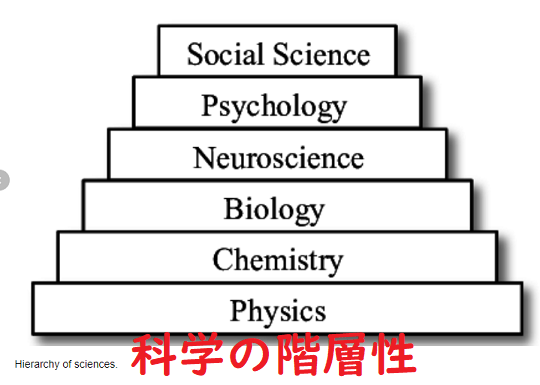
【この点については、『人間の知識』(pp.267-269)から次の一節を引用しておこう。】
「ひとつの対象の構造を示すことは、その対象の諸部分について、また、諸部分が相互に関係する仕方について、言及することである(たとえば)我々が解剖学を学んでいるとすると、我々はまず様々な骨の名前と形とを学び、 その後、各々(それぞれ)の骨が骨格のどの部分に属するかを教えられるかもしれない(might 可能性がある)。その時は、我々は、解剖学が骨格について言うことを有している限り(範囲)において、骨格を知ることになるであろう。しかし、骨格の構造(structure in relation to the skelton)について言うことができることの全てを尽くしたことにはならないであろう。 骨は細胞からなっており、細胞は分子 からなっており、分子は化学が研究するところの原子構造をもっている(訳注:ただし、科学は一つ一つの原子の構造については言及しない)。原子は、今度は、物理学が研究するような構造をもっている(訳注:原子核+電子 → 素粒子)。現在一般に認められている科学(注:1959年の時点!)は、この点(point 度合い/段階)で分析を中止している。しかし、さらに進んだ分析が不可能であると想定すべき理由は全くない。我々は(本書の)後の方で、物理的存在を事象(出来事)からなる構造にまで分析することについて述べる(提案する)機会を持つであろうし、事象(出来事)すら、後に私が示そうと試みるように、構造を持つものであtp考えるのが得策である。(with advantage 利点がある)」 「次に、幾分ちがった構造の例、即ち、文(の構造)について考えてみよう。文は語(単語など)の系列(語がいくつかつらなったもの)であり、文が話される場合には時間的前後の関係による順序に配列されており、書かれた文であれば、左から右へ(訳注:アルファベットの場合!)の関係による順序に配列されてい。しかし、これらの関係は、実は、語と語の間の関係ではなく、 語の個別的事例 (instances) (同士)の間の関係である(訳注:。ひとつの語とは、類似する音(noises)の集合であり、それらはすべて同じ意味またはほとんど同じ意味をもっている(話を単純化するために、私は書かれた文字ではなく話された言葉に限定しよう)。 ひとつの文もまた音(noises :不快で非音楽的な音)の集合である。なぜなら多くの人が同じ文を発話できるからである(訳注:たとえば、「ポチ」という語がありますが、その場に3人の人がいて、3人が「ポチ」という語を発声すれば、「ポチ」という語の3つの発話例 instances が生じることになります)。 そこで、文とは語(words)の時間的系列であると言うべきではなく、それは音(noise)の集合であり、しかもそれら音(noise)はおのおのまた、迅速な時系列の音(noise)からなり、しかもまた、この音(noise)各々の語(word)の個別的事例であるようなものである(これは一つの文の必要な特質であって十分な特質でない。 十分でないというのは(なぜならば)、語の系列の中には有意義でないものもありうるからである)。さて私は様々な品詞(different parts of speech)の区別に長居することなく(これ以上詳しく論ずることはやめて)、統語論(syntax 構文)には属せず、音韻論に属するところの、次の分析の段階に進もう。一つの語(a wordの各事例(each instance)は複合的な音(sound)であり、それらの諸部分は個々の文字(separate letters)である(ただし 文字は音標文字 phonetic alphabet を仮定する)。このような音韻分析の彼方(behind 後に/先に)に、さらに次の分析の段階がある。それは一つひとつの文字を発音したり聞いたりする、複雑な(人間の)生理過程の分析の第かいがある。 生理学的分析の彼方(先)には、物理学の分析があり、さらにこの点から先へ分析は進むが、それは骨について考えたのと同じである。 ・・・・・・」 「後になってそれ自身複合的であるとわかるような単位(units)から出発して構造を説明することには何の誤りはない。たとえば、点は事象(出来事)の集合として定義されうるが、だからといって、点を単純なもの(simple 構造をもたないもの)として扱った伝統的な幾何学(訳注:ユークリッド幾何学のこと)が誤まっていたということにはならない。構造についての説明は、全てある単位に相対的なものであり、その単位は、当面は、あたかも構造をもたないものであるかのごとく扱われる。 しかし、それらの単位が、別の文脈(コンテキスト)においては構造をもち、それを認めることが重要でありうることを、否定してはならないのである。」
Chapter 13: language, n.8 (As to this, I will quote the following passage from Human Knowledge (pages 267-9):) To exhibit the structure of an object is to mention its parts and the ways in which they are interrelated. If you were learning anatomy, you might first learn the names and shapes of the various bones, and then be taught where each bone belongs in the skeleton. You would then know the structure of the skeleton in so far as anatomy has anything to say about it. But you would not have come to an end of what can be said about structure in relation to the skeleton. Bones are composed of cells, and cells of molecules, and each molecule has an atomic structure which it is the business of chemistry to study. Atoms, in turn, have a structure which is studied in physics. At this point orthodox science ceases its analysis, but there is no reason to suppose that further analysis is impossible. We shall have occasion to suggest the analysis of physical entities into structures of events, and even events, as I shall try to show, may be regarded with advantage as having a structure. ‘Let us consider next a somewhat different example of structure, namely sentences. A sentence is a series of words, arranged in order by the relation of earlier and later if the sentence is spoken, and of left to right if it is written. But these relations are not really between words; they are between instances of words. A word is a class of similar noises, all having the same meaning or nearly the same meaning. (For simplicity I shall confine myself to speech as opposed to writing.) A sentence also is a class of noises, since many people can utter the same sentence. We must say, then, not that a sentence is a temporal series of words, but that a sentence is a class of noises, each consisting of a series of noises in quick temporal succession, each of these latter noises being an instance of a word. (This is a necessary but not a sufficient characteristic of a sentence; it is not sufficient because some series of words are not significant.) I will not linger on the distinction between different parts of speech, but will go on to the next stage in analysis, which belongs no longer to syntax, but to phonetics. Each instance of a word is a complex sound, the parts being the separate letters (assuming a phonetic alphabet). Behind the phonetic analysis there is a further stage: the analysis of the complex physiological process of uttering or hearing a single letter. Behind the physiological analysis is the analysis of physics, and from this point onward analysis proceeds as in the case of the bones. . . . ‘There is nothing erroneous in an account of structure which starts from units that are afterwards found to be themselves complex. For example, points may be defined as classes of events, but that does not falsify anything in traditional geometry, which treated points as simples. Every account of structure is relative to certain units which are, for the time being, treated as if they were devoid of structure, but it must never be assumed that these units will not, in another context, have a structure which it is important to recognize.’
Source: My Philosophical Development, 1959, by Bertrand Russell
More info. https://russell-j.com/beginner/BR_MPD_13-080.HTM
